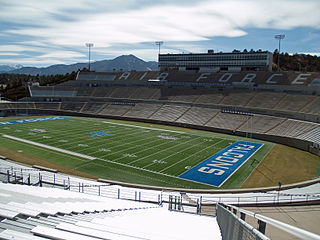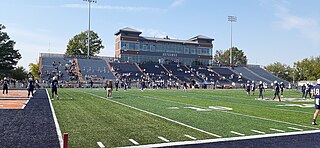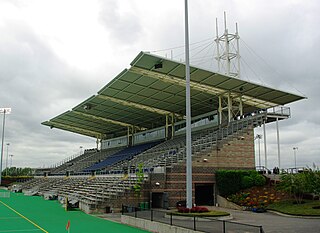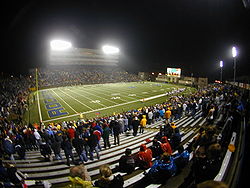
SECU Stadium is an outdoor athletic stadium on the campus of the University of Maryland in College Park, Maryland. It is the home of Maryland Terrapins football and men's lacrosse teams, which compete in the Big Ten Conference. The facility was formerly named Byrd Stadium after Harry "Curley" Byrd, a multi-sport athlete, football coach, and university president in the first half of the 20th century, and temporarily Maryland Stadium after objections to Byrd's naming due to his history of supporting segregation.

Kroger Field, also known as Commonwealth Stadium, is a stadium in Lexington, Kentucky, United States, located on the campus of the University of Kentucky that primarily serves as the home field for the Kentucky Wildcats football team. The stadium is located at the corner of Alumni Drive and University Drive in Lexington. The playing surface is named C. M. Newton Grounds in honor of the late UK athletic director and former baseball and basketball player C. M. Newton. Built in 1973, it is the newest football stadium in the Southeastern Conference, as measured by date of original construction. The original capacity for the stadium was 57,800. In the stadium's first game, played on September 15, 1973, the Wildcats defeated the Virginia Tech Hokies 31–26.

Alumni Stadium is a football stadium located on the lower campus of Boston College in Chestnut Hill, Massachusetts, approximately 6 miles (9.7 km) west of downtown Boston. It is the home of the Boston College Eagles. Its present seating capacity is 44,500.

Skelly Field at H. A. Chapman Stadium is an outdoor college football stadium in the south central United States, located on the campus of the University of Tulsa in Tulsa, Oklahoma. Commonly known as H. A. Chapman Stadium, it is the home field for the Tulsa Golden Hurricane of the American Athletic Conference.

David Booth Kansas Memorial Stadium is a football stadium located in Lawrence, Kansas, on the campus of the University of Kansas. The stadium was opened in 1921, and is the seventh oldest college football stadium in the country, and is widely recognized as the oldest west of the Mississippi River. Nicknamed "The Booth", the stadium is dedicated as a memorial to Kansas students who died in World War I, and is one of seven major veterans' memorials on the campus. The stadium is at the center of all seven war memorials—adjacent to the stadium, further up the hill is a Korean War memorial honoring Kansas students who served, just a few hundred feet south of the stadium stands the University of Kansas World War II Memorial, the Kansas Memorial Campanile and Carillon, the University of Kansas Vietnam War Memorial sits adjacent to the Campanile to the west, the Victory Eagle – World War I statue located on Jayhawk Boulevard, southeast of the stadium, and the Kansas Memorial Union, a veterans' memorial that also houses the main university student union and bookstore, located east of the stadium. The stadium is the home stadium of the Kansas Jayhawks football team.
Dragon Stadium is a stadium in Southlake, Texas, used primarily for American football games. The stadium serves the Carroll ISD, and is the home of the Carroll Senior High School Dragons football team. In 2003, the stadium was used by the Major League Soccer club Dallas Burn before the franchise moved to their permanent home at Toyota Stadium.

Memorial Stadium is a stadium in Bloomington, Indiana, United States. It is primarily used for football, and has been the home of Indiana Hoosiers football since its opening in 1960. It is the tenth largest stadium in the Big Ten Conference, with a capacity of 52,626. The field has a conventional north-south alignment, at an approximate elevation of 771 feet (235 m) above sea level.

Falcon Stadium is an outdoor football stadium in the western United States, on the campus of the U.S. Air Force Academy near Colorado Springs, Colorado. It is the home field of the Air Force Falcons football and lacrosse teams of the Mountain West Conference, and also holds the academy's graduation ceremonies each spring.

Floyd Casey Stadium was a stadium in Waco, Texas. The stadium was used for 64 seasons before being replaced by McLane Stadium in 2014. It was primarily used for football, and was the home field of the Baylor Bears. The stadium, located about four miles from the Baylor University campus, cost $1.8 million to build and sat 50,000 people. Originally named Baylor Stadium, it opened in 1950 with a Baylor game against the Houston Cougars. On December 7, 2013, Baylor played its last game in the stadium, against the Texas Longhorns, where the attendance record of 51,728 was established. Baylor won 19 of its final 20 games played at the stadium.

University Stadium is an outdoor football stadium in the western United States, located on the south campus of the University of New Mexico in Albuquerque, New Mexico. It is the home field of New Mexico Lobos football, which competes as a member of the Mountain West Conference.

Plaster Stadium is a 17,500-seat football stadium located in Springfield, Missouri. It is home to the Missouri State Bears football team.

Walter J. Zable Stadium at Cary Field, named for Walter J. Zable, former member of the College of William & Mary Board of Visitors, is located in Williamsburg, Virginia and is the home of the William and Mary Tribe football team. It is located centrally in the William & Mary campus, adjoining the Sadler Center building and situated on Richmond Road. The stadium is used for football and track & field. It has an official capacity of 12,672 fans. The attendance figures for William and Mary football games are usually inexact, however, since students are not counted among the official results in an accurate fashion. The area of Cary Field behind the stadium was the baseball field for William and Mary until the opening of Plumeri Park in 1999.

Allen E. Paulson Stadium is a 25,000-seat on-campus football stadium in Statesboro, Georgia. It is home to the Georgia Southern Eagles football team and the focal point of Erk Russell Athletic Park.

Arthur J. Rooney Athletic Field, commonly known as simply Rooney Field, is a 2,200-seat multi-purpose facility in Pittsburgh, Pennsylvania. Situated on the campus of Duquesne University, Rooney Field is the home field of the Duquesne Dukes football, soccer and lacrosse teams.

Hardy M. Graham Stadium is a 7,500-seat multi-purpose stadium in Martin, Tennessee. It is home to the University of Tennessee at Martin Skyhawks football team. The facility opened in 1964. It is located north of Tennessee State Route 431 from the central campus area, adjacent to the Ned McWherter Agricultural Complex.

Joan C. Edwards Stadium, formerly Marshall University Stadium, is a football stadium located on the campus of Marshall University in Huntington, West Virginia, United States. It currently can hold 30,475 spectators and includes twenty deluxe, indoor suites, 300 wheelchair-accessible seating, a state-of-the-art press-box, 14 concession areas, and 16 separate restrooms. It also features 90,000 sq ft (8,000 m2) of artificial turf and 1,837 tons of structural steel. It also houses the Shewey Athletic Center, a fieldhouse and a training facility. The new stadium opened in 1991 and replaced Fairfield Stadium, a condemned off-campus facility built in 1927 in the Fairfield Park neighborhood.

Hillsboro Stadium is a multi-sport stadium in the northwest United States, located in Hillsboro, Oregon, a suburb west of Portland. Opened 25 years ago in 1999 and owned by the city of Hillsboro, the award-winning stadium is part of the Gordon Faber Recreation Complex located in the northeast part of the city, adjacent to the Sunset Highway.

Washington–Grizzly Stadium is an outdoor college football stadium in the western United States, located on the campus of the University of Montana in Missoula, Montana. Opened 38 years ago in 1986, it is home to the Montana Grizzlies, a member of the Big Sky Conference in Division I FCS.
Robert Rice Stadium was an outdoor athletic stadium in Salt Lake City, Utah, located on the campus of the University of Utah. Originally opened in 1927 as Ute Stadium, it was the home of the Utah Utes football team. Renamed for Robert L. Rice in 1972, it was almost completely demolished after the 1997 season to make way for the Utes' current home, Rice-Eccles Stadium, which occupies the same physical footprint.
The 1990 Toledo Rockets football team represented the University of Toledo during the 1990 NCAA Division I-A football season. The Rockets were led by first-year head coach Nick Saban, and competed as a member of the Mid-American Conference (MAC). They finished the season with a record of nine wins and two losses and as MAC co–champions with Central Michigan.



















